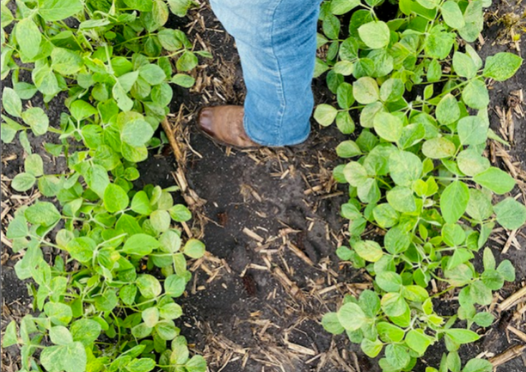Planting a crop can be an emotional roller coaster for a farmer, besides selling grain too soon. My grandfather would say “put your bare bottom” on the soil and if you cringe, it’s too cold and too early to plant. Based off how often I heard this same story this past spring, the generation prior to us was definitely one of the greatest. The last three springs have brought up a lot of debate on when we should or should not be planting. In general, a soybean plant can withstand early season challenges better than a corn plant. And when the soil is cool and dry, it’s hard not to take advantage of good running field days in the early spring.
It is important to evaluate the risks and rewards of planting soybeans early. I would like to take some time to provide a follow up on the value that came from early planting soybean. Below are some examples of early planting soybean (planted April 4) and later planting soybeans (planted May 27) in Central Illinois.

Left: May 27; Right: April 4
Risk to Planting Early:
- Replant
- Frost
- Cool/Wet Soils
There is no doubt that when planting soybeans early, there is a higher risk of replant vs. later planting. However, with free replant options from seed companies, and re-plant payments from crop insurance, there is a risk to replant, however there is not a big financial risk associated (if the business is managed progressively). It’s important to make this decision based on economics and business and not based on emotions. Over the years I have seen more replant and poor root systems and stands from waiting to plant early, and then when the season gets late, good field workdays are limited and quality planting conditions get pushed and are questionable.
Rewards to Planting Early:
- Being efficient with equipment and labor, planting when you can.
- Bigger root systems
- Handles stress better
- Bigger Canopy
- More sunlight harvesting
- Reduced weed pressure
- Not impacted by herbicide spray restriction dates
- Yield
- More nodes
- More trifoliate
- More pods and blooms
How to evaluate:
When driving down the road, anyone can start seeing differences in potential planting date variation, primarily based off canopy development and row closures, which can be associated as a biological advantage to planting early. Now is a great time to be evaluating the potential yield advantage by physically getting out in fields and starting to count and measure differences. Now, we all know that a soybean plant is on a continual roller coaster and just because a plant has good counts now, does not mean it will always lead to higher yields. I’m a firm believer that it’s not yours until it’s in the bin. However, I’m also a firm believer that final yield is a result of the potential that was established, and if grain fill environments are favorable, top end yield is obtainable. As you can see from the chart below, the early planting soybeans have aggressively more nodes, trifoliate and potential blooms, and pods, which means it’s set up for higher harvest yields. Think about it, the later planted fields are going to be going through major vegetative growth and reproductive growth during mid- to late-July when it’s usually a very stressful time of year. Again, early planting has a lot of yield established, whereas late planting has a lot of catching up to do.

Recommendation:
- Do not allow the risk of planting early be the reason that you can’t take advantage of the rewards from early planting. Take time to better understand the regional risk that you have, and then work with a strong, progressive-thinking CCA to work through options that can minimize the potential risk.
- It’s about the numbers. Work through some “what-if” scenarios on potential reward for high yields compared to the actual cost if you had to replant 50 percent, 75 percent, or even 100 percent of your acres. Consider attractive free-replant policies with seed companies and replant funds through crop insurance, then decide for yourself if the financial reward and stronger canopy reward is worth the risk.

Soybeans planted May 27. Picture taken July 12.

Soybeans planted April 4. Picture taken July 12.

Soybeans planted April 4. Picture taken July 12.




 and then
and then